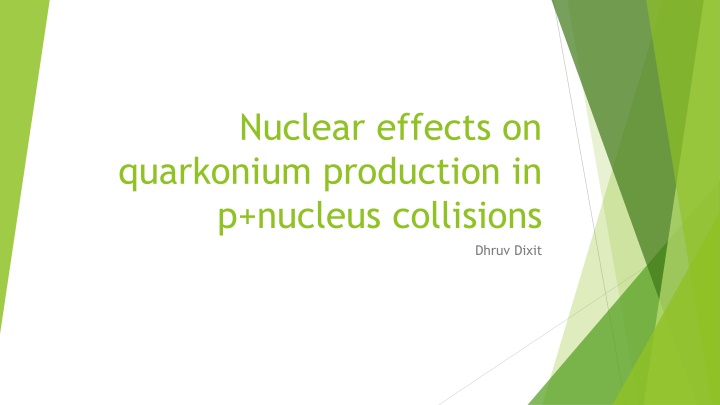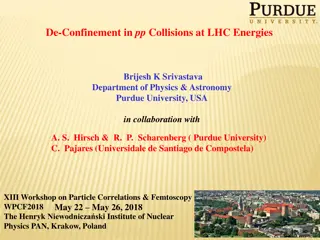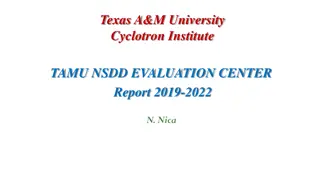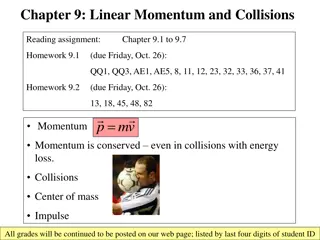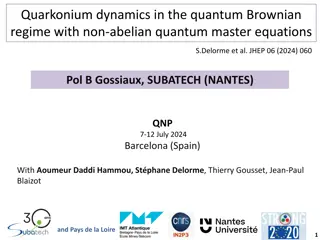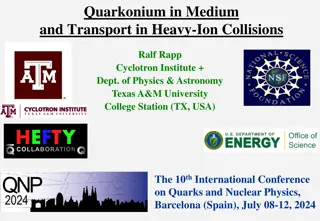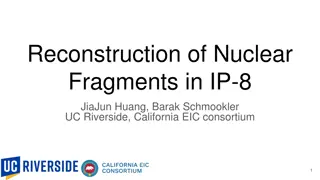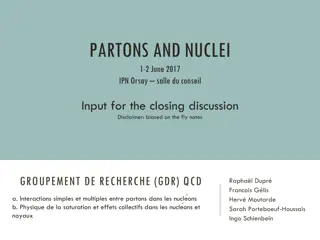Insights into Quarkonium Production in Nuclear Collisions by Dhruv Dixit
Quarkonium mesons, such as Charmonium and Bottomonium, provide crucial information in understanding the effects of nuclear matter on their production in proton-nucleus collisions. These mesons, composed of quark-antiquark pairs, exhibit different behaviors in hot mediums, making them valuable probes for exploring properties of the Quark-Gluon Plasma. The study also discusses Cold Nuclear Matter Effects, Gluon Shadowing, and Suppression Factors observed in these collisions.
Download Presentation

Please find below an Image/Link to download the presentation.
The content on the website is provided AS IS for your information and personal use only. It may not be sold, licensed, or shared on other websites without obtaining consent from the author.If you encounter any issues during the download, it is possible that the publisher has removed the file from their server.
You are allowed to download the files provided on this website for personal or commercial use, subject to the condition that they are used lawfully. All files are the property of their respective owners.
The content on the website is provided AS IS for your information and personal use only. It may not be sold, licensed, or shared on other websites without obtaining consent from the author.
E N D
Presentation Transcript
Nuclear effects on quarkonium production in p+nucleus collisions Dhruv Dixit
Outline Quarkonium: What are they? What they reveal? Types: J/ (Charmonium)and (Bottomonium) Suppression in P+A Cold Nuclear Effects D. Dixit 290E S17 8/18/2024 2
Qurakonium Meson made of quark-anti quark pair Two possibilities: Charmonium (c c-bar) J/ and (2S) Bottomonium (b b-bar) D. Dixit 290E S17 8/18/2024 3
Why look at quarkonium? Bottomonium 3 states Y(1S), Y(2S), Y (3S) The binding energy of the (2S) state ( 540 MeV) is about half that of the (1S) state ( 1.1 GeV); the (3S) is still more weakly bound at 200 MeV. Help identify the temperature of the hot medium Charmonium Longer lifetime than bottomonium Good hard probes to explore properties of QGP due to a longer duration of strong interaction Both can also be used to look at saturation physics D. Dixit 290E S17 8/18/2024 4
Cold Nuclear Matter Effects Gluon Shadowing Nuclear absorption The probablitity that the quark anti-quark pair will make it through the medium with out Calculated using the absorption cross-section of the D. Dixit 290E S17 8/18/2024 5
Suppression factor D. Dixit 290E S17 8/18/2024 6
Suppression due to medium effects J/ suppression seen in a RpA vs eta plot. Dotted curve presents nuclear suppression of J/ as function of rapidity in pA collisions calculated with the analytic formula Eq. (12). Dashed curve presents more accurate numerical calculations with the full dipole cross section Eq. (2). Solid curve is corrected for gluon shadowing. Data are for d-Au collisions at s = 200 GeV [10]. https://arxiv.org/pdf/1008.4272.pdf D. Dixit 290E S17 8/18/2024 7
Suppression due to medium effects Nuclear suppression of production as function of rapidity in pA collisions at s = 200 GeV (upper curve, gold) and s = 5.5 TeV (two bottom curves, lead). The bottom dashed curve includes only the effects of bb dipole break-up and high twist shadowing of beauty production, solid curve is corrected for gluon shadowing. https://arxiv.org/pdf/1008.4272.pdf D. Dixit 290E S17 8/18/2024 8
Suppression due to medium effects The cross-section yield for the upsilon in d-Au and pp. As we can see, the yield is less and the upsilon mesons are suppressed. D. Dixit 290E S17 8/18/2024 9
Cold nuclear effect comparison to PbPb Cold Nuclear Matter effects on J/ production with extrinsic PT at sNN = 2.76 TeV at the LHC. Nuclear Physics A 855 (2011) 327 330 D. Dixit 290E S17 8/18/2024 10
Sources https://arxiv.org/pdf/1204.4609.pdf https://arxiv.org/pdf/0912.4498.pdf https://arxiv.org/pdf/1305.1724.pdf https://arxiv.org/pdf/1310.2230.pdf https://arxiv.org/pdf/1008.4272.pdf Physics Letters B 735 (2014) 127 137 Nuclear Physics A 855 (2011) 327 330 Nuclear Physics A 956 (2016) 689 692 D. Dixit 290E S17 8/18/2024 11
